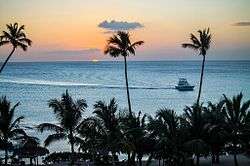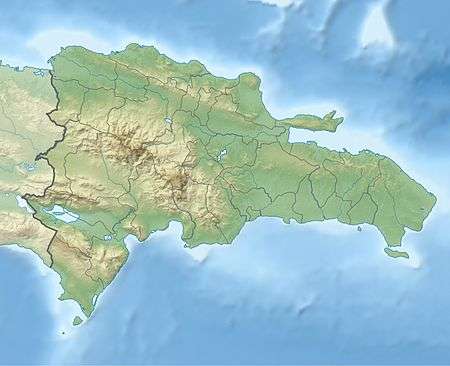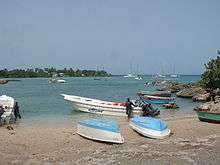Bayahibe
Bayahíbe is a town in the Dominican Republic, located about 10 miles (16 km) east of La Romana on the shore of the Caribbean Sea. Founded as a fishing village in 1874 by Juan Brito and his family, who came from Puerto Rico, the town is now a tourist destination.
Bayahíbe | |
|---|---|
Distrito Municipal | |
 Sunset in Bayahibe Beach | |
 Bayahíbe | |
| Coordinates: 18°22′N 68°50′W | |
| Country | |
| Province | La Altagracia |
| Population | |
| • Total | 2,000 (approx) |
| Time zone | UTC-4 (Atlantic) |
| Postal code | 23000 |
| Area code(s) | 809 |
Etymology
Bayahíbe is an indigenous word. Its meaning is not known for sure, but there are many names that include the Tainos word "Baya." "Baya" is the name given to a bivalve mollusk, like clams that are glued to the rocks or roots of mangrove trees. "Jib" (or "hib") is the name of a sieve manufactured from sticks used to sift cassava flour.
Tourism

Bayahíbe Beach, a public beach, is located less than a mile from the town center, and Dominicus Beach is in about three miles' distance. Bayahíbe serves as an embarkation point for boat trips to Saona Island,[1] a thinly inhabited island with extensive beaches located in a national park. In the vicinity of Bayahíbe and Dominicus Beach, numerous large resorts are located.
Scuba diving and other watersports
Scuba diving is probably the most common tourist attraction in Bayahíbe—Bayahíbe being the best location for scuba in the Dominican Republic. There are numerous scuba diving shops scattered around the main beach that take scuba divers to the many dive sites around the area. There are over 20 official dive sites located near Bayahíbe and all are accessible from the dive boats in the area. There are three shipwrecks in the area including the Atlantic Princess, St George and Coco.[2] Bayahíbe benefits from the crystal clear, calm waters of the Caribbean Sea which makes it perfect for many water sports including snorkeling and stand up paddle boarding. Deep sea fishing is another popular activity.
Infrastructure
The electricity is powered by Consorcio Energético Punta Cana-Macao (CEPM), a wind and solar energy producer led by US-based Argentine businessman Rolando Gonzalez-Bunster.[3]
The Bayahibe rose

In Bayahíbe grows a small group of plants that are extremely important to the biological characteristics of this area: in particular, the pereskia quisqueyana. This plant species is endemic to Bayahíbe.[4] It is known for its beautiful flowers.[5] The popular name by which this pink flower is known is "Bayahíbe rose."
Audrey Mestre
On October 12, 2002, Audrey Mestre, French world record-setting free-diver, died while attempting to free-dive to a depth of 171 metres (561 ft) off the coast of Bayahíbe.[6]
References
- "Saona Cruise Excursions". La Romana Excursions. Retrieved 3 March 2017.
- Diving DR. "Dive Sites". Retrieved 2010-09-24.
- "Company Overview of Consorcio Energético Punta Cana - Macao, S.A." Bloomberg. Retrieved October 20, 2016.
- PUCMM. "Pereskia Quisqueyana" (in Spanish). Archived from the original on 2011-05-26. Retrieved 2010-09-24.
- "Punta Bayahibe" (in Spanish). Arqueotur. Retrieved 3 March 2017.
- Christopher Clarey. "A free-diver's death : Tragic plunge to the limits". Retrieved 2014-10-08.